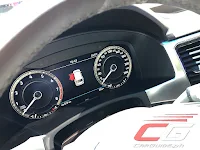April 22, 2019
Can the Volkswagen Teramont Go Against the Ford Explorer, Mazda CX-9, and Hyundai Palisade?
Large, boxy, and fitted with 7 seats—Volkswagen’s Teramont SUV certainly has the right recipe for success. Known as the Atlas in the U.S. where it originated, tailored to American needs, the Teramont has since taken a decidedly more luxurious approach; a reflection of Volkswagen’s premium mainstream positioning in markets such as the Middle East, China, and yes, even the Philippines.
It’s the largest vehicle produced on Volkswagen’s MQB platform and it’s a strategic vehicle designed to conquer new markets for the German automaker. In the Philippines, the Teramont is likely going to be one of two new SUVs that Volkswagen Philippines will launch before the end of the year (the other, likely being the T-Cross).
Produced in China (as well as in the U.S.), the Teramont is one large SUV: at 5,037 millimeters in length, 1,979 millimeters in width, and 1,768 millimeters in height, it’s roughly the same size as the Ford Explorer, Hyundai Palisade, and Mazda CX-9. It even has a 2,980 millimeter wheelbase, easily fitting three rows of seats (6 and 7-seater configurations are available), while luggage volume ranges from 409 to 2,415 liters.
In China, the Teramont comes with three basic engine configurations: the 330 TSI, 380 TSI, and 530 V6. The 330 TSI models are equipped with a 2.0-liter EA888 4-cylinder turbocharged engine that makes 186 horsepower and 320 Nm of torque. The same engine is also found in the 380 TSI, but in this guise, it makes 252 horsepower and 350 Nm of torque. At the top is the 530 V6 which swaps the 4-banger for a 2.5-liter EA390 turbocharged V6 making 300 horsepower and 500 Nm of torque. In any of these engines, Volkswagen’s 4 Motion intelligent all-wheel drive is standard and the only transmission is the DQ500 wet-type dual clutch.
Whatever the drivetrain, the Teramont is available in three variants: Comfort, Deluxe, and Ultimate. Even in the “entry-level” Comfort guise, it comes with 18-inch alloy wheels, LED headlights and fog lights, powered front seats, a cooled glove box, three-zone climate control, and an 8-speaker sound system. On higher-trimmed models, features such as 19 or 20-inch wheels, Nappa leather, panoramic sunroof, dynamic cruise control, automatic parking, and a 12-speaker Dynaudio sound system are available.
Now to the most interesting part: the price. In China, the Teramont starts at RMB 300,900 (~ P 2,320,000) and tops out at (~ P 3,900,000). Using the Santana 1.5L Comfortline as basis, it’s sold in China at 111,800 RMB (~ P 861,800), compared to P 962,000 locally. Applying the 11 percent price difference, the Teramont could start here anywhere from P 2,552,000 to P 4,290,000.
It must be remembered however that Volkswagen Philippines did try to sell a vehicle north of 4 million with limited success before (the Touareg). With that, it’s a safe assumption that Volkswagen will not do the same mistake and will instead take a closer look at their competitors to price the Teramont. Thus, the likely candidate would be either the 330 TSI or 380 TSI models. If that’s the case, expect a price tag of about P 2,552,000 (330 TSI Comfortline) to 3,542,000 (380 TSI Ultimate)—certainly competitive against the Explorer (P 2,798,000 to P 3,178,000), Palisade (P 3,240,000), and CX-9 (P 2,380,000 to P 2,950,000).
Filed Under:
Mid-sized SUV,
News,
Volkswagen Teramont
Subscribe to:
Post Comments (Atom)












No comments:
Post a Comment
Feel free to comment or share your views. Comments that are derogatory and/or spam will not be tolerated. We reserve the right to moderate and/or remove comments.